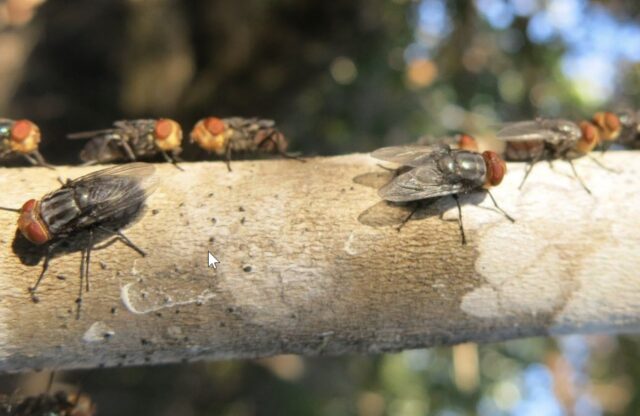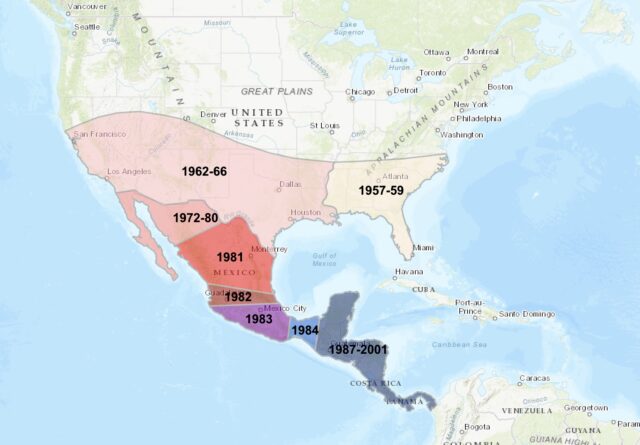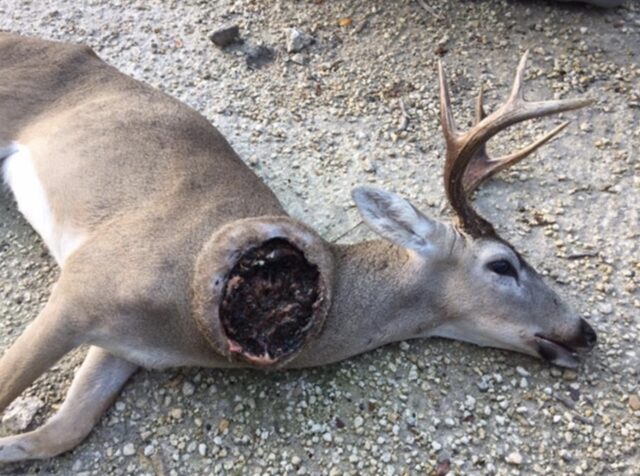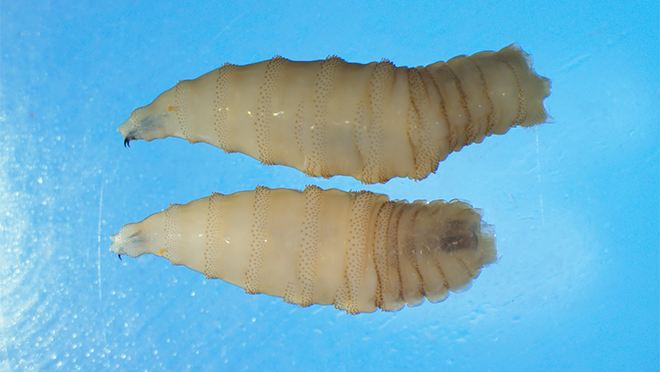US is now scrambling to use aerial bombs of sterilized flies to halt the spread.
We're on the verge of being screwwormed.
The biological barrier was breached, they're slithering toward our border, and the US Department of Agriculture is now carpet-bombing parts of Mexico with weaponized flies to stave off an invasion.
This is not a drill. Screwworms are possibly the most aptly named parasites imaginable, both literally and figuratively. Screwworms—technically, New World Screwworms—are flies that lay eggs on the mucous membranes, orifices, and wounds of warm-blooded animals. Wounds are the most common sites, and even a prick as small as a tick bite can be an invitation for the savage insects.
Once beckoned, females lay up to 400 eggs at a time. Within about a day, ravenous flesh-eating larvae erupt, which both look and act like literal screws. They viciously and relentlessly bore and twist into their victim, feasting on the living flesh for about seven days. The result is a gaping ulcer writhing with maggots, which attracts yet more adult female screwworms that can lay hundreds more eggs, deepening the putrid, festering lesion. The infection, called myiasis, is intensely painful and life-threatening. Anyone who falls victim to screwworms is figuratively—well, you know.

Previous victories
Screwworms aren't a new foe for the US. Decades ago, they were endemic to southern areas of the country, as well as the whole of Central America, parts of the Caribbean, and northern areas of South America. While they're a threat to many animals, including humans, they are a bane to livestock, causing huge economic losses in addition to the carnage.
In the 1950s, the US began an intensive effort to eradicate screwworms. The successful endeavor required carefully inspecting animals and monitoring livestock movements. But most importantly, it relied on a powerful method to kill off the flies.
The ploy—called the Sterile Insect Technique—throws a wrench into the unique life cycle of screwworms. After the larvae feast on flesh, they fall to the ground to develop into adults, a process that takes another seven days or so during warm weather. Once adults emerge, they can live for around two weeks, again depending on the weather. In that time, females generally only mate once, but don't worry—they make the most of the one-night stand by retaining sperm for multiple batches of eggs. While females lay up to 400 eggs at once, they can lay up to 2,800 in their lives.
After carefully studying the life cycle, USDA scientists figured out a way to sterilize male fly larvae with doses of gamma radiation without hurting the males' abilities to find mates. USDA scientists then used small aircraft to bomb screwworm-riddled areas with millions of sterile male flies. The onslaught of sterilized flies elbows out fertile ones from their one-time chances of mating with a female, cratering the population.
The method is remarkably successful. Screwworms were eradicated from the US by about 1966. Through the 1970s, '80s, and '90s, the frontline of the worms was pushed down through Central America. Screw worms were eventually declared eradicated from Panama in 2006. That year, the USDA partnered with Panama to build a sterile fly production facility that would be used to maintain a biological barrier along the Darién Gap at the border of Panama and Columbia. Along the barrier, sterile flies have been released by air at least once a month since the eradication, according to Mark Fox, an entomologist with the US Centers for Disease Control and Prevention, who gave a clinical presentation on screwworms in October.

Risk of resurgence
For decades, the US and Central America have mostly been free of screwworms, a fact that is estimated to have saved US farmers $900 million every year. There was a blip in 2016 when screwworms mysteriously showed up in the Florida Keys, producing ghastly wounds on the islands' adorable and endangered Key deer, the smallest of North America’s white-tailed deer. But with intensive efforts and about 188 million sterile flies, the outbreak was declared over by the end of March 2017. The source of the screwworms was never identified.
Now, the US is staring down a more significant threat. In 2022, the biological barrier at the Darién Gap was breached. By July 2023, screwworms reached Costa Rica, then Nicaragua in March 2024, and Honduras by September 2024. Now, they are in Mexico.

In February, the USDA announced it was shifting its aerial sterile fly bombings from Panama to Mexico to try to halt the northward advancement. In comments this week, Agriculture Secretary Brook Rollins said that the parasites are currently south of Mexico's Isthmus of Tehuantepec, the narrowest strip of land between the Gulf of Mexico and the Pacific Ocean. The overall goal is to push them back down to the Darién Gap.
But the effort to force the worms southward will be challenging. In the CDC's October presentation warning clinicians of the threat, Fox and other experts noted that keeping the parasites from spreading has been difficult. Challenges include varied topography that makes surveillance tricky, indigenous communities in hard-to-reach areas, communication barriers, inadequate wound care in animals, and continued transportation of animals through unmonitored checkpoints.
Clinical horrors
Compared to humans, livestock and other animals are at far greater risk from screwworms' resurgence. For instance, there were at least 18,553 animal cases in Panama last October but only 79 human cases in the country. Still, when screwworms get a taste for human flesh, it's not pretty. The infection is extremely painful, and every single one of the larvae must be physically removed—and again, there are often hundreds. The procedure typically requires surgery.
As CDC Medical Officer Rebecca Chancey remarked in the clinical presentation, the larvae are "pretty tenacious and hang on pretty tightly, so oftentimes, you know, a great deal of force is required to remove them." Once the larvae are out, doctors must remove necrotic tissue, clean the wound, treat for any secondary infections, and try to manage the pain.
There have been at least three human cases of screwworm myiasis in the US in recent years: In 2014, a 26-year-old US woman fell asleep on a beach in the Dominican Republic after drinking and came home with an infestation of screwworm larvae in her ear. In 2023, a 64-year-old man took a trip to Argentina and Brazil soon after having surgery on his cheek. Larvae were visible in the surgical wound before he left, and his cheek bandage reportedly fell off during his flight home. And last year, an immunosuppressed man traveled to the Dominican Republic and came back with an infestation in his nose and sinus cavities. (You can watch extremely graphic footage of US doctors trying to remove them here.)
Hope you enjoyed this news post.
Thank you for appreciating my time and effort posting news every day for many years.
News posts... 2023: 5,800+ | 2024: 5,700+ | 2025 (till end of April): 1,811
RIP Matrix | Farewell my friend ![]()
- elena1024 and Mutton
-

 2
2



3175x175(CURRENT).thumb.jpg.b05acc060982b36f5891ba728e6d953c.jpg)
Recommended Comments
There are no comments to display.
Join the conversation
You can post now and register later. If you have an account, sign in now to post with your account.
Note: Your post will require moderator approval before it will be visible.